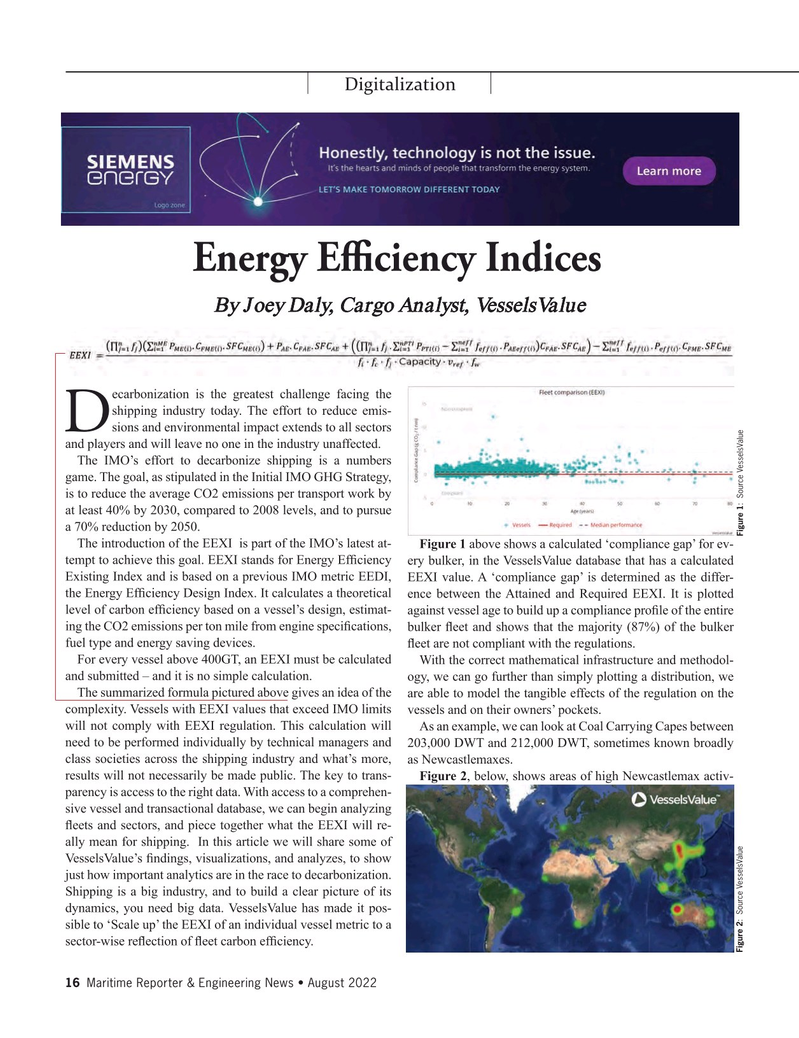
Page 16: of Maritime Reporter Magazine (August 2022)
The Shipyard Annual
Read this page in Pdf, Flash or Html5 edition of August 2022 Maritime Reporter Magazine
Digitalization
Energy Ef ciency Indices
By Joey Daly, Cargo Analyst, VesselsValue ecarbonization is the greatest challenge facing the shipping industry today. The effort to reduce emis-
D sions and environmental impact extends to all sectors and players and will leave no one in the industry unaffected.
The IMO’s effort to decarbonize shipping is a numbers game. The goal, as stipulated in the Initial IMO GHG Strategy, is to reduce the average CO2 emissions per transport work by at least 40% by 2030, compared to 2008 levels, and to pursue a 70% reduction by 2050.
The introduction of the EEXI is part of the IMO’s latest at- Figure 1 above shows a calculated ‘compliance gap’ for ev- tempt to achieve this goal. EEXI stands for Energy Ef? ciency ery bulker, in the VesselsValue database that has a calculated
Existing Index and is based on a previous IMO metric EEDI, EEXI value. A ‘compliance gap’ is determined as the differ- the Energy Ef? ciency Design Index. It calculates a theoretical ence between the Attained and Required EEXI. It is plotted level of carbon ef? ciency based on a vessel’s design, estimat- against vessel age to build up a compliance pro? le of the entire ing the CO2 emissions per ton mile from engine speci? cations, bulker ? eet and shows that the majority (87%) of the bulker fuel type and energy saving devices. ? eet are not compliant with the regulations.
For every vessel above 400GT, an EEXI must be calculated With the correct mathematical infrastructure and methodol- and submitted – and it is no simple calculation. ogy, we can go further than simply plotting a distribution, we
The summarized formula pictured above gives an idea of the are able to model the tangible effects of the regulation on the complexity. Vessels with EEXI values that exceed IMO limits vessels and on their owners’ pockets.
will not comply with EEXI regulation. This calculation will As an example, we can look at Coal Carrying Capes between need to be performed individually by technical managers and 203,000 DWT and 212,000 DWT, sometimes known broadly class societies across the shipping industry and what’s more, as Newcastlemaxes.
results will not necessarily be made public. The key to trans- Figure 2, below, shows areas of high Newcastlemax activ- parency is access to the right data. With access to a comprehen- sive vessel and transactional database, we can begin analyzing ? eets and sectors, and piece together what the EEXI will re- ally mean for shipping. In this article we will share some of
VesselsValue’s ? ndings, visualizations, and analyzes, to show just how important analytics are in the race to decarbonization.
Shipping is a big industry, and to build a clear picture of its dynamics, you need big data. VesselsValue has made it pos- sible to ‘Scale up’ the EEXI of an individual vessel metric to a sector-wise re? ection of ? eet carbon ef? ciency.
Figure 2: Source VesselsValue Figure 1: Source VesselsValue 16 Maritime Reporter & Engineering News • August 2022
MR #8 (1-17).indd 16 8/4/2022 12:18:23 PM

 15
15

 17
17
